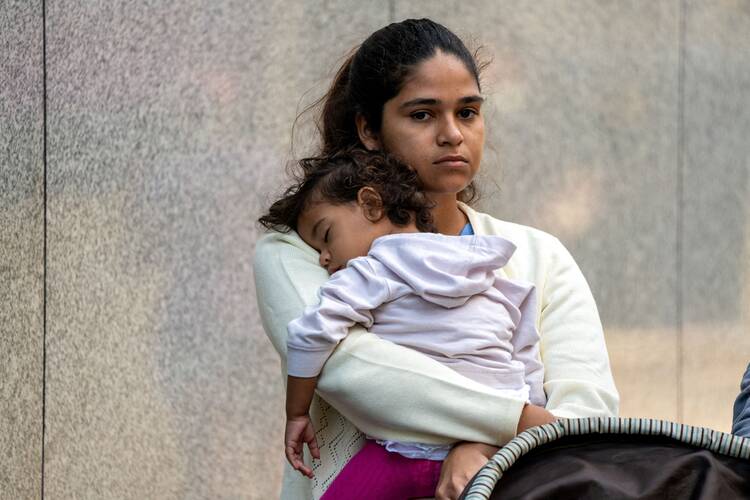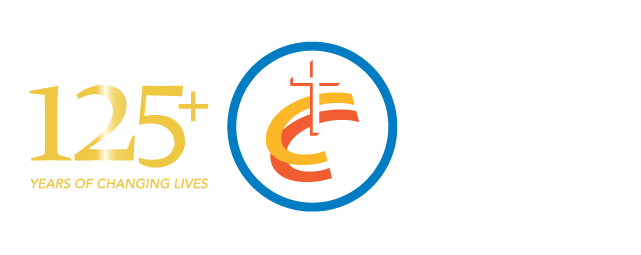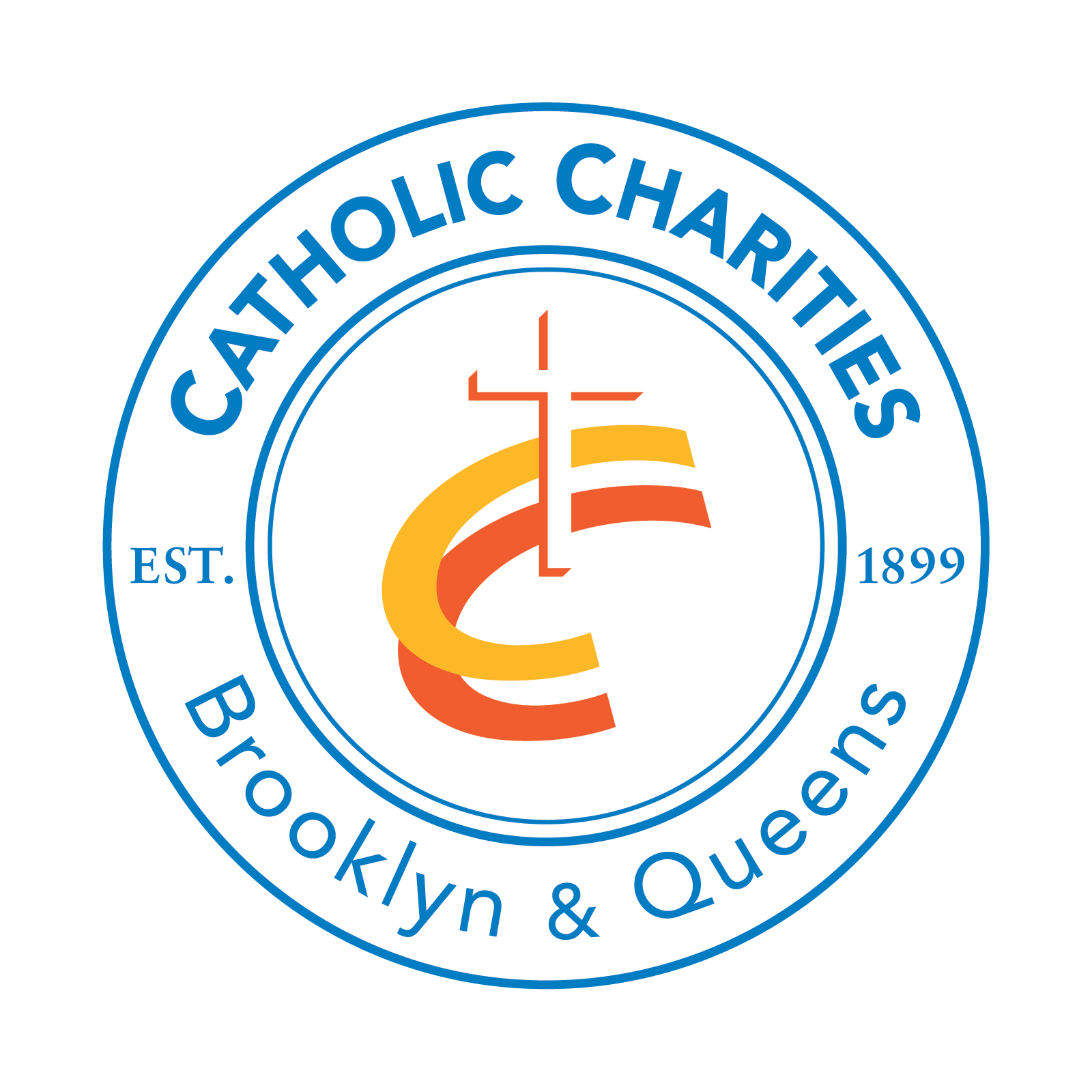
A migrant and her daughter wait for aid outside the offices of Catholic Charities in New York City, Aug. 16, 2022, after being transported via charter bus from Texas. (OSV News photo/David Delgado, Reuters)
September 15, 2023
By Delaney Coyne
Wilfredo, a 25-year-old asylum seeker, fled political violence in his native Ecuador by foot. He described a perilous trek across seven countries, including a difficult passage through the Darién Gap, 60 miles of lush, roadless jungle that separates Colombia and Panama. It took him 28 days to reach the United States.
Nothing tragic happened to the group of Ecuadoreans he traveled with, “thank God,” he said, though during their time in the Darién Gap, he came upon many deceased children and struggling pregnant women. He stopped to help the people he could—the ones who were still alive.
New York City’s “right to shelter” policy has contributed to its comparably low homelessness rate since it was established in 1979, but the recent surge of migrants has strained social services.
As political leaders at the city, state and national levels struggle to coordinate a response, the issue has become a political cudgel in the leadup to the 2024 election. Major papers have published images of migrants lined up outside of the Roosevelt Hotel, and Mayor Eric Adams has gone so far as to say that the migrant crisis “will destroy New York City.” The political noise has not distracted Catholic Charities team members, however, who have stepped up to meet the basic needs of the migrants who show up at their door.
Adapting to the New York’s migrant crisis
According to the mayor’s office, more than 104,000 migrants have arrived in New York since the spring of 2022. Many went straight to Catholic Charities for help. Since July 2022, Catholic Charities Brooklyn and Queens has assisted about 8,000 asylum seekers in finding housing and formalizing their immigration status, though C.C.B.Q. is not a housing provider itself.
A Catholic Charities community outreach center is often one of the first stops for new arrivals to the city. Much of the aid its staff provides involves referrals and assistance in connecting with city and state resources.
“It’s been challenging” to serve this influx of migrants, said Richard Slizeski, a senior vice president in Catholic Charities’ Office of Mission. Still, he sees his work as “a real privilege,” connecting aid to these contemporary migrants to the biblical demand to assist the widow, the orphan and the sojourner.
As political leaders at the city, state and national levels struggle to coordinate a response, the issue has become a political cudgel in the leadup to the 2024 election.
“The whole agency, not just the Office of Mission, is really lifting up the dignity of every single person and particularly serving the most vulnerable,” said Mr. Slizeski. So as buses of migrants began to show up at offices in 2022, Catholic Charities expanded its efforts.
“We pulled in a lot of people from the community,” to deal with this latest surge of asylum seekers, said Mr. Slizeski. Among them was outreach coordinator Deacon Manuel Quintana, a lawyer who assists migrants with their paperwork each week. “It just seemed there was such a need,” said Deacon Quintana, explaining how he became involved.
Getting the right referrals is especially urgent for those seeking asylum, said Deacon Quintana, since acquiring a coveted work permit is contingent on a completed application for asylum and a five-month waiting period. Catholic Charities brought in more staff to help translate and file the English-language paperwork.
Although the initial migrant surge to New York overwhelmingly consisted of Central American migrants, Mr. Slizeski said that in recent weeks many West African migrants have arrived at the center. “There’s a whole new language set” for staff to deal with, he said, “some of which are really beyond us.” The office has been adding Arabic speakers and other interpreters that can speak to these latest migrants.
“We deal as best we can with that,” Mr. Slizeski said.
The staff is committed to meeting the needs of those who show up at their door, many of whom have few resources and are often traumatized by their journeys. Deacon Danny Rodriguez, another outreach coordinator, said much of their help consists of providing legal services and connecting families with services for their children. “We try to go through it with them, give them a sense of comfort, [a] sense of welcoming because a lot of them are scared… They don’t know what’s the next step.”
‘Creating something beautiful’
Wilfredo arrived in New York City in December 2022. He said that other migrants from around the world had told him that New York was a place that would provide substantial help to new immigrants. But even with that help, the migrant experience has not been easy.
Although the initial migrant surge to New York overwhelmingly consisted of Central American migrants, in recent weeks many West African migrants have arrived.
“When I started here, I wanted to look for a job,” Wilfredo said, “but it is very difficult to look for jobs here if you do not speak English or do not have work experience.” Sensing this need, Catholic Charities started their own safety training program from the federal Occupational Safety and Health Administration for migrants looking for jobs in construction.
When Wilfredo started his O.S.H.A. training, he met the instructor, called “Professor Jorge,” by his students, who came to the United States from Colombia as an asylum seeker himself 23 years ago. Jorge requested his surname not be used for his safety and the safety of his students. According to Jorge, the O.S.H.A. program at Catholic Charities has been expanded to address the greater numbers of newcomers to the city.
Jorge said the people he has met have come to build a future for themselves and their children. He sees his work as a way of giving back to those going through the same thing he did when he first arrived in the United States.
For Wilfredo, who had worked as a mining administrator in Ecuador, the O.S.H.A. training represented a major opportunity—it not only allowed him to develop employable skills but also to find community and purpose in New York. “It’s a lonely city,” Wilfredo said. “There are no friends here. There are acquaintances here—very few friends.” In Jorge, he found a friend who inspired him to volunteer, even though Wilfredo is a new arrival himself.
Jorge asked Wilfredo how he wanted to contribute to the community and contribute to God. Unsure of what he had to offer, “that was the only time…that I’ve remained silent in my life,” the talkative Wilfredo recalled.
Wilfredo has decided that starting his own construction business might be the best way to use his talent and skills to help the Latino immigrant community in New York. He is committed to using his resources to create “something beautiful.”
Amid political turmoil, hope
New York’s struggle to absorb its thousands of new residents has made headlines around the country. It has similarly proved challenging for Catholic Charities Brooklyn and Queens to contribute what it can, but staff in Brooklyn Heights report that they have made progress collaborating with the city despite the political turmoil. Their optimism marks a stark contrast with the tense rhetoric surrounding the New York’s migrant crisis in the headlines.
Major papers have published images of migrants lined up outside of the Roosevelt Hotel, and Mayor Eric Adams has gone so far as to say that the migrant crisis “will destroy New York City.”
Pointing out that there has been a housing crisis in New York that long predates the current struggle to find lodging for these newcomers, Deacon Quintana said he does not pay attention to “anybody who spends their time baselessly criticizing the city.”
“For me, it’s kind of like Pope Francis’ ‘culture of encounter,’” said John Gonzalez, Catholic Charities’ director of parish and community relations for Brooklyn. He said he prefers not to engage in the discord emerging out of the political fracas over immigrants. “Our focus isn’t the political divide,” he said.
“Could there have been a better system? Absolutely… But the fact of the matter is they’re here. So that’s where we have to be,” Mr. Gonzalez said.
Most staff members expressed a hope for a more robust response to the crisis from the federal government, but insisted Catholic Charities would continue its efforts with or without federal assistance. “If we find a shut door, then we just try to find another avenue to get around. We have to be creative,” Mr. Gonzalez said.
Deacon Rodriguez said, “We try to educate [the migrants] on how to be a part of a system that doesn’t want them, so we try to help them fit in. We cry together; we laugh together; we listen to their stories. [That is] something a lot of people don’t do.”
As a newcomer to this big city, “Yes, you feel alone,” Wilfredo said. But now “the most beautiful thing here is that I believe in myself; I believe in the people who are next to me. I believe in many people with whom I have surrounded myself, many good people.”
Read the original story in America Magazine: As New York’s migrant crisis makes headlines, Catholic Charities gets to work


